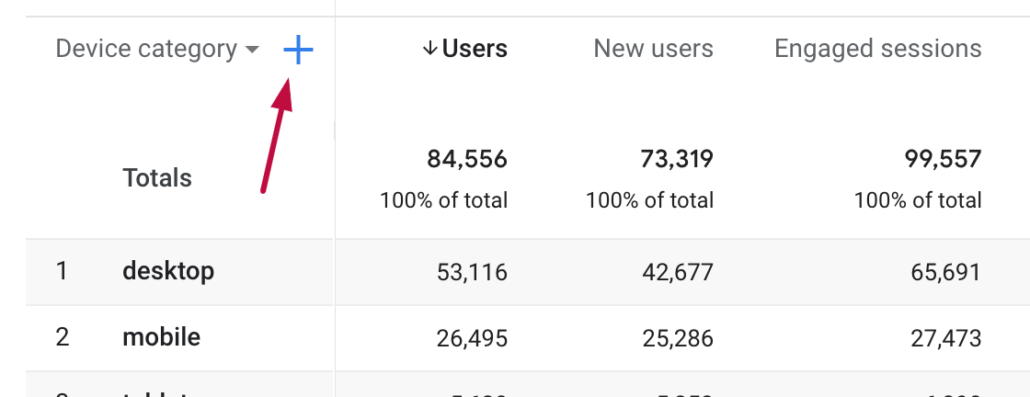Mastering Secondary Dimension in Google Analytics: A Complete Guide
Mastering Secondary Dimension in Google Analytics: A Complete Guide
Blog Article
Transform Your Analytics Method With Secondary Dimension in Google Analytics
By incorporating additional dimensions into information evaluation, a new layer of insights arises, shedding light on detailed individual actions and communications. The critical application of second dimensions holds the essential to opening a treasure chest of indispensable info that can revolutionize how businesses act and translate upon their data.
Understanding Additional Dimensions in Google Analytics
Additional dimensions in Google Analytics offer extra context to main data by permitting individuals to analyze metrics across a second measurement, supplying deeper insights into customer actions and interactions on a website. Secondary Dimension in Google Analytics. While primary measurements supply fundamental information factors such as pageviews, bounce price, and session period, secondary dimensions use an even more detailed sight by segmenting the main data better. This segmentation allows customers to evaluate metrics in mix with one more measurement, such as website traffic resources, demographics, or customer habits
Advantages of Utilizing Second Measurements
Using secondary measurements in Google Analytics provides a calculated benefit by improving the deepness of analysis and offering a much more thorough understanding of customer communications and actions on a web site. By incorporating additional dimensions, experts can get valuable insights right into the performance of specific sectors or variables within their information. This makes it possible for a much more thorough assessment of individual behavior beyond surface-level metrics, enabling a deeper exploration of the aspects affecting user interaction and conversions.

Exactly How to Apply Secondary Measurements
When including secondary dimensions in Google Analytics, one essential action is to pick the appropriate metrics and measurements to enhance the analysis process. To execute additional dimensions successfully, begin by accessing your Google Analytics account and navigating to the report you intend to boost with extra information. When in the record, find the "Additional Dimension" button, generally found over the information table. Clicking on this button will certainly open up a drop-down menu listing various measurements that can be added to your key measurement for deeper insights.
After selecting the proper second dimension, such as 'Source/Medium' or 'Device Category,' Google Analytics will certainly present the information in a more comprehensive format, permitting you to cross-analyze different aspects of customer behavior. Bear in mind to he said try out various combinations of key and additional measurements to reveal valuable patterns and trends that can notify your advertising strategies. By carrying out secondary measurements thoughtfully, you can obtain an extra comprehensive understanding of your internet site or app performance and make data-driven decisions to optimize your electronic visibility.
Analyzing Data With Secondary Measurements
Boost your information evaluation in Google Analytics by integrating additional measurements to dive much deeper right into individual behavior patterns and maximize your electronic marketing techniques properly - Secondary Dimension in Google Analytics. By including second measurements to your primary data, you can obtain important insights that can help you make educated decisions regarding your website or application efficiency
Assessing information with second dimensions allows you to segment your primary data further, offering a much more comprehensive view of customer communications. Combining the key dimension of 'source/medium' with a second measurement like 'touchdown page' can expose which specific web pages are driving website traffic from different resources. This details can be instrumental in refining your web content method or enhancing your ad campaign to increase conversions.
Additionally, making use of additional measurements enables you to determine connections in between different metrics, helping you understand the impact of various elements on user habits. Whether it's assessing demographics alongside individual interaction metrics or tool categories with conversion rates, secondary dimensions equip you to uncover concealed fads and patterns that can lead your advertising efforts.
Enhancing Performance With Additional Dimensions
To improve the effectiveness of data evaluation and decision-making in Google Analytics, including secondary dimensions is key to optimizing performance metrics and gaining deeper understandings right into customer actions patterns. By making use of second measurements, experts can dig beyond surface-level data and discover important relationships that might otherwise go undetected. This optimization method enables companies to customize their advertising initiatives better, identify areas for improvement in site functionality, and improve overall customer experience.
Second dimensions offer an even more thorough sight of user interactions by giving extra context to primary information metrics. As an example, matching the primary measurement of 'landing page' with an additional dimension like 'tool classification' can reveal whether specific devices are more most likely to drive engagement on details touchdown pages. This understanding can notify receptive style improvements or targeted advertising strategies to enhance performance.

Verdict
To conclude, the integration view of second measurements in Google Analytics offers companies with an effective tool to enhance their analytics approach. Secondary Dimension in Google Analytics. By delving deeper into customer behavior and communications, marketing experts can discover beneficial insights that can drive efficiency optimization and enhance the overall individual experience. Leveraging secondary measurements enables a much more extensive evaluation of information, causing more educated decision-making and tailored advertising and marketing efforts
Second dimensions in Google Analytics supply additional context to main information by allowing individuals to analyze metrics across a 2nd dimension, supplying deeper understandings into customer habits and communications on a site. While key dimensions supply essential information points such as pageviews, bounce price, and session period, secondary measurements provide an even more comprehensive sight by segmenting the primary data further.One of the crucial benefits of using secondary measurements is the ability to discover correlations and patterns that might not be promptly obvious when assessing data with key dimensions alone.When including second dimensions in Google Analytics, one crucial step is to choose the pertinent metrics and dimensions to enhance the analysis procedure. Coupling the primary measurement of additional reading 'touchdown web page' with a second dimension like 'tool classification' can disclose whether specific gadgets are extra likely to drive interaction on certain landing web pages.
Report this page